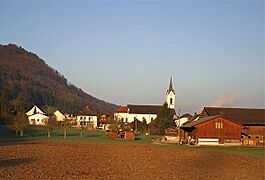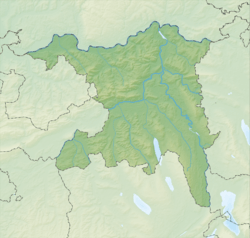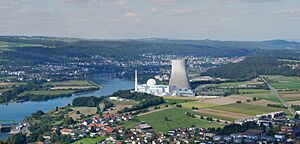Leibstadt facts for kids
Quick facts for kids
Leibstadt
|
||
|---|---|---|

Leibstadt village
|
||
|
||
| Country | Switzerland | |
| Canton | Aargau | |
| District | Zurzach | |
| Area | ||
| • Total | 6.4 km2 (2.5 sq mi) | |
| Elevation | 347 m (1,138 ft) | |
| Population
(Dec 2020 )
|
||
| • Total | 1,404 | |
| • Density | 219.4/km2 (568/sq mi) | |
| Postal code |
5325
|
|
| Surrounded by | Dogern (DE-BW), Full-Reuenthal, Leuggern, Schwaderloch, Wil | |
Leibstadt is a small town, also called a municipality, located in the canton of Aargau in Switzerland. It's part of the Zurzach district.
Contents
Leibstadt's Past: A Journey Through History
Leibstadt was first mentioned around the year 1240. For many years, in the 13th and 14th centuries, it was controlled by the powerful Habsburg family. Records from 1323 show that there were already two mills working in Leibstadt.
How Leibstadt Became One Town
For a long time, Leibstadt was actually two separate villages: Oberleibstadt and Unterleibstadt. A small creek divided them. After 1415, these two parts were ruled by different groups. Oberleibstadt was part of the Austrian area, while Unterleibstadt was part of the Swiss Confederation. Because it was a border village, Leibstadt was often in danger when the Habsburgs and the Swiss fought. In 1499, a chronicle tells us that attackers burned most of the villages nearby, including Leibstadt.
Between 1635 and 1798, Leibstadt and a nearby village called Schwaderloch formed a special district. It wasn't until 1866 that Oberleibstadt and Unterleibstadt finally joined together to become the single municipality of Leibstadt we know today.
Schools and Churches in Leibstadt
The very first school in Leibstadt was started in 1756. Later, in 1880, Leibstadt formed its own Catholic church parish, separate from Leuggern. The old village chapel burned down in 1871, but a new, beautiful parish church was built in its place between 1879 and 1880.
Modern Changes: Trains and Power
A railway station opened in Leibstadt in 1892, connecting it to other towns. However, this station closed in 1993. Now, people mostly use Postauto buses to travel to and from Leibstadt. For a long time, farming was the main way people made a living here.
A big change happened in 1973 when a nuclear power company, Leibstadt AG, was created. They built the largest nuclear power plant in Switzerland right here in Leibstadt! It started producing electricity in 1984 and cost about 4.8 billion Swiss francs. This plant produces a huge amount of electricity each year and provides about three-fifths (or 60%) of all the jobs in the community.
Leibstadt's Natural Surroundings
Leibstadt covers an area of about 6.39 square kilometers (about 2.47 square miles). A large part of this land, about 43.7%, is used for farming. Forests cover another 34.1% of the area. The rest of the land, about 18.5%, is where buildings and roads are located. A small part, 3.4%, is made up of rivers.
Where Leibstadt is Located
The town is nestled between the Wandfluh mountain and the famous Rhine river. Leibstadt is known as a haufendorf village. This means it's an irregular, unplanned village with buildings packed closely together, often around a central square. It also includes a smaller settlement called Bernau.
Leibstadt's Coat of Arms
The official symbol, or blazon, of Leibstadt's coat of arms is described as: Gules a Bend per bend Argent and Sable. This means it has a red background with a diagonal stripe that is half silver and half black.
Who Lives in Leibstadt?
Leibstadt has a population of about 1,282 people. Around 36.6% of the people living here are from other countries. Most people in Leibstadt, about 84.7%, speak German. The second most common language is Albanian (8.8%), followed by Italian (1.9%).
Age Groups in Leibstadt
In Leibstadt, about 10.3% of the population are children aged 0 to 9 years old. Teenagers, aged 10 to 19, make up about 13.3% of the population. This shows that Leibstadt is home to many young people and families.
Places to See in Leibstadt
Leibstadt is famous for its large Leibstadt Nuclear Power Plant. It's a very impressive structure. In 2003, an activist was able to climb onto the reactor dome, which brought a lot of attention to the plant.
You can also visit the Looreto Chapel in Bernau, which was built in 1672. It used to be the private chapel for a noble family who lived there. Not far from the town, you can find the old ruins of Bernau Castle, which are interesting to explore.
Leibstadt's Economy and Jobs
Leibstadt has a low unemployment rate, which means most people who want to work can find jobs. In 2005, about 74 people worked in farming, and there were 24 businesses related to agriculture. A much larger number, 581 people, worked in the manufacturing and construction industries, with 22 businesses in this area. The service sector, which includes things like shops and offices, employed 267 people across 32 businesses.
Many people who live in Leibstadt also work in the town. The nuclear power plant is a major employer, providing many jobs for the community. About 12.3% of working people use public transportation to get to their jobs, while 48.8% use their own cars.
Religious Life in Leibstadt
According to a census from 2000, most people in Leibstadt, about 59.6%, are Roman Catholic. Another 15.3% belong to the Swiss Reformed Church.
Learning and Education in Leibstadt
Leibstadt values education. About 65.2% of adults (aged 25–64) have completed either high school or gone on to higher education, like university. In the 2008/2009 school year, there were 96 students attending primary school and 115 students attending secondary school in the municipality.
Images for kids






